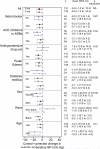Dry-weight reduction in hypertensive hemodialysis patients (DRIP): a randomized, controlled trial
- PMID: 19153263
- PMCID: PMC2679163
- DOI: 10.1161/HYPERTENSIONAHA.108.125674
Dry-weight reduction in hypertensive hemodialysis patients (DRIP): a randomized, controlled trial
Abstract
Volume excess is thought to be important in the pathogenesis of hypertension among hemodialysis patients. To determine whether additional volume reduction will result in improvement in blood pressure (BP) among hypertensive patients on hemodialysis and to evaluate the time course of this response, we randomly assigned long-term hypertensive hemodialysis patients to ultrafiltration or control groups. The additional ultrafiltration group (n=100) had the dry weight probed without increasing time or duration of dialysis, whereas the control group (n=50) only had physician visits. The primary outcome was change in systolic interdialytic ambulatory BP. Postdialysis weight was reduced by 0.9 kg at 4 weeks and resulted in -6.9 mm Hg (95% CI: -12.4 to -1.3 mm Hg; P=0.016) change in systolic BP and -3.1 mm Hg (95% CI: -6.2 to -0.02 mm Hg; P=0.048) change in diastolic BP. At 8 weeks, dry weight was reduced 1 kg, systolic BP changed -6.6 mm Hg (95% CI: -12.2 to -1.0 mm Hg; P=0.021), and diastolic BP changed -3.3 mm Hg (95% CI: -6.4 to -0.2 mm Hg; P=0.037) from baseline. The Mantel-Hanzel combined odds ratio for systolic BP reduction of > or =10 mm Hg was 2.24 (95% CI: 1.32 to 3.81; P=0.003). There was no deterioration seen in any domain of the kidney disease quality of life health survey despite an increase in intradialytic signs and symptoms of hypotension. The reduction of dry weight is a simple, efficacious, and well-tolerated maneuver to improve BP control in hypertensive hemodialysis patients. Long-term control of BP will depend on continued assessment and maintenance of dry weight.
Trial registration: ClinicalTrials.gov NCT00067665.
Figures




Comment in
-
Assessing blood pressure control in dialysis patients: finally a step forward.Hypertension. 2009 Mar;53(3):448-9. doi: 10.1161/HYPERTENSIONAHA.108.126300. Epub 2009 Jan 19. Hypertension. 2009. PMID: 19153262 No abstract available.
References
-
- Go AS, Chertow GM, Fan D, McCulloch CE, Hsu CY. Chronic kidney disease and the risks of death, cardiovascular events, and hospitalization. N Engl J Med. 2004;351:1296–1305. - PubMed
-
- Sarafidis PA, Li S, Chen SC, Collins AJ, Brown WW, Klag MJ, Bakris GL. Hypertension awareness, treatment, and control in chronic kidney disease. Am J Med. 2008;121:332–340. - PubMed
-
- Agarwal R, Nissenson AR, Batlle D, Coyne DW, Trout JR, Warnock DG. Prevalence, treatment, and control of hypertension in chronic hemodialysis patients in the United States. Am J Med. 2003;115:291–297. - PubMed
-
- Agarwal R. Assessment of blood pressure in hemodialysis patients. Semin Dial. 2002;15:299–304. - PubMed
-
- Converse RL, Jr, Jacobsen TN, Toto RD, Jost CMT, Cosentino F, Fouad-Tarazi F, Victor RG. Sympathetic overactivity in patients with chronic renal failure. N Engl J Med. 1992;327:1912–1918. - PubMed

